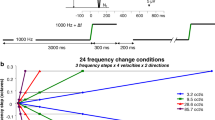Summary
Many authors consider the nature of the slow acoustically evoked potentials to be partly a specific one. Therefore the AEP-time behavior probably contains more information about the functional state of the acoustical channel than it is got by the usual measurement of only 3 values (N1P2-amplitude, 2 latencies). A test of this hypothesis is possible with a multivariate mathematical procedure, which involves the whole AEP-time behavior. We are using the multivariate variance- and discriminant analysis.
For the application of this statistical method random samples of patients with certain otologic diseases are needed. To avoid mistakes in grouping these samples some preliminary investigations had been necesssary: This paper reports the results of multivariate investigations concerning age differences of the AEP in normal hearing adults.
By means of the multivariate variance analysis the AEP of 3 age groups were examined (group 1: 15–34 years, group 2: 35–44 years, group 3: 45–60 years).
At 1000 Hz as well as at 4000 Hz significant differences between the group averages were found, which were not detectable by the usual N1P2-amplitude measurement.
Furthermore with the discriminant analysis it is possible to perform a relatively reliable differentiation between the individual AEP of the age groups 1 and 3.
Zusammenfassung
Da ein Beitrag spezifischer Hirnstrukturen zur Entstehung des langsamen akustisch evozierten Potentials (AEP) als gesichert gilt, ist es wahrscheinlich, daß das AEP mehr Information über den Funktionszustand des akustischen Sinneskanals enthält, als die bisher übliche Ausmessung von nur 3 Werten (N1P2-Amplitude, 2 Latenzen) liefert. Die Prüfung dieser Hypothese ist mit einem multivariaten mathematischen Verfahren möglich, das den gesamten AEP-Zeitverlauf in die Analyse einbezieht. Wir arbeiten gegenwärtig mit der multivariaten Varianz- und Diskriminanzanalyse.
Als statistisches Verfahren geht diese Analyse von Stichproben aus, in unserem Fall von Patientengruppen mit bestimmten otologischen Erkrankungen. Um Fehler bei der Zusammensetzung dieser Stichproben zu vermeiden, waren Voruntersuchungen zur Altersabhängigkeit des AEP bei normalhörenden Erwachsenen erforderlich, über deren Ergebnisse hier berichtet wird.
Mittels der multivariaten Varianzanalyse wurden die AEP von 3 Altersgruppen (Gruppe 1: 15–34 Jahre, Gruppe 2: 35–44 Jahre, Gruppe 3: 45–60 Jahre) untersucht. Sowohl bei 1000 Hz als auch bei 4000 Hz konnten dabei signifikante Unterschiede zwischen den Gruppenmittelwerten der 3 Altersklassen gefunden werden, die mit der üblichen N1P2-Amplitudenauswertung (t-Test) nicht nachweisbar sind.
Weiterhin ist mit Hilfe der Diskriminanzanalyse eine relativ sichere Unterscheidung der individuellen Potentiale der Altersgruppen 1 und 3 möglich.
Similar content being viewed by others
Literatur
Ahrens, H., Läuter, J.: Mehrdimensionale Varianzanalyse. Berlin: Akademie-Verlag 1974
Freigang, B., v. Specht, H., Kevanishvili, Z. S.: Experimentelle Hinweise auf den unterschiedlichen Entstehungsmechanismus der späten akustisch evozierten Potentiale. Vortrag auf II. Bilateralen ERA-Symposium, Eisenach 1976
Kevanishvili, Z. S., v. Specht, H., Kajaia, O. A.: Amplitude and latency studies of the human slow auditory evoked responses to tones of different frequencies. Estrat. da Minerva Otorinolaringologica 24, 230–243 (1974)
Perronet, P., Michel, F., Echallier, J. F., Girod, J.: Coronal topography of human auditory evoked responses. Electroenceph. clin. Neurophysiol. 37, 225–230 (1974)
Stürzebecher, E., Wernecke, K.-D., Wagner, H.: ERA-Kennlinien bei normalhörenden Personen. Acta oto-laryng. 80, 294–300 (1975)
Vaughan, H. G., Jr., Ritter, W.: The sources of auditory evoked responses recorded from the human scalp. Electroenceph. clin. Neurophysiol. 28, 360–367 (1970)
Author information
Authors and Affiliations
Additional information
Neuere Untersuchungen haben ergeben, daß infolge der relativ geringen Stichprobenumfänge der zufällige Anteil an den Differenzen der Stichprobenmittelwerte noch nicht zu vernachlässigen ist. Die Möglichkeit der Altersklassifizierung individueller AEP muß daher auf der Basis größerer Stichproben nochmals überprüft werden. Die grundsätzliche Aussage über die AEP-Altersdifferenzen bleibt jedoch bestehen.
Rights and permissions
About this article
Cite this article
Stürzebecher, E., Wernecke, KD., Wagner, H. et al. Der Nachweis von Altersveränderungen des langsamen akustisch evozierten Potentials bei Erwachsenen mittels der multivariaten statistischen Analyse. Arch Otorhinolaryngol 218, 19–25 (1977). https://doi.org/10.1007/BF00469730
Received:
Issue Date:
DOI: https://doi.org/10.1007/BF00469730



